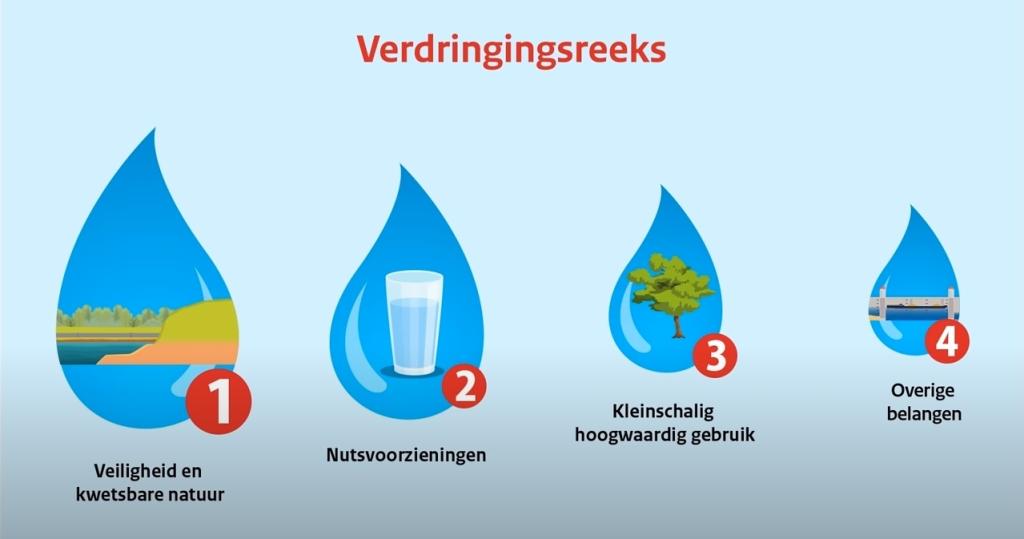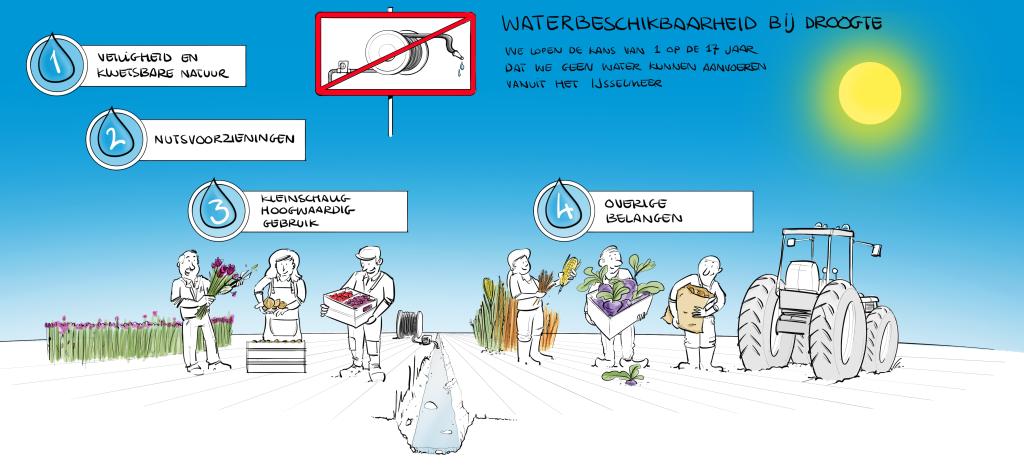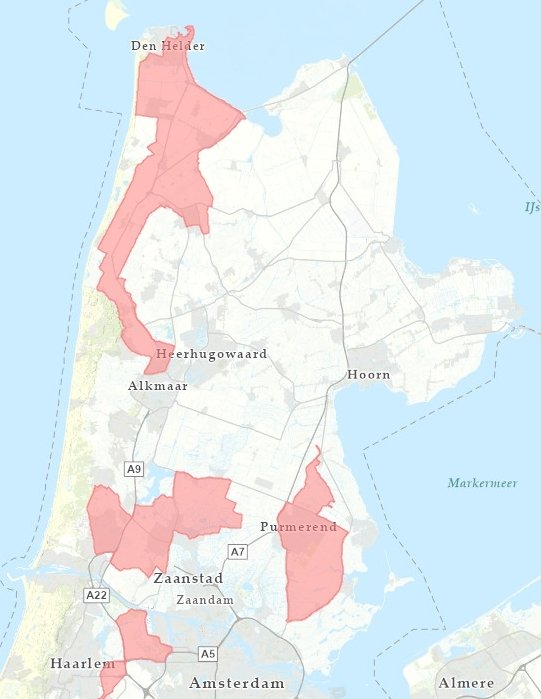Drought and water distribution
Water availability in drought conditions
Prolonged drought and heat are becoming more common. When there is no rain and the water evaporates, we have less and less water in our ditches. We can then import water from the IJsselmeer and Markermeer lakes. But if no rain falls in the rest of Europe either and the IJsselmeer lake is also no longer sufficiently replenished with water via the Rhine and the IJssel, we have to distribute the available surface water.

Distribution of available water
The available water then goes first to the things that matter most, such as Health for our levees, drinking water supply and power plants. Other things such as crop irrigation, shipping and recreation get lower priority. Below you can see which facilities and activities belong to which category. Category 1 has the highest priority and category 4 the lowest.

Nationally determined, regionally developed
We call this (national) prioritization the displacement series. It indicates which issues take priority over other issues in water distribution. Categories 3 and 4 were then worked out regionally by the provinces and water boards in the Water Distribution Strategy.
The HHNK Water Distribution Strategy was adopted by our General Board on February 28, 2024.
Web viewer level enforcement during drought
The animation below shows how water is distributed when less water is/will be available.
Even in dry periods, we try to provide water to farmers as much and as long as possible. We first take measures that lead to water conservation, such as limiting lock movements and closing fish passages. But if the drought continues, it may be necessary to prohibit the withdrawal of surface water for irrigation. This particularly affects the agricultural sector.
Minimizing social and economic damage is central to the establishment of withdrawal bans. This means that low-yielding agricultural crops are the first to be affected by abstraction bans. Crops with higher yields per hectare, so-called "capital-intensive crops," can in principle be supplied with water longer. To determine the order in which crops face withdrawal bans, we use WUR's NSO typing as an objective source for crop yield per hectare.

The use of surface water for irrigation, in the event of increasing scarcity, is phased out in three steps:
- Low-yielding, yield per hectare less than €2,000;
- Average yield, yield per hectare between €2,000 and €10,000 per hectare;
- High-yield, or capital-intensive crops, yield per hectare over €10,000.
Withdrawal bans
On Texel there is a year-round withdrawal ban. This is because of the vulnerability of the area and because no water supply is possible here.
There are also areas where you may not use surface water for growing starch and consumer potatoes and tomatoes due to brown rot bacteria. This is important for vegetable gardens where tomatoes and potatoes are grown. Based on research, the Netherlands Food and Consumer Product Safety Authority (NVWA) annually determines the areas where these withdrawal bans are in effect. These areas can be found on the NVWA website.

Tightening water distribution agreements
After the dry summer of 2018, Rijkswaterstaat, all provinces and the water boards around the IJsselmeer region made new agreements on the distribution of water in consultation with the important users of fresh water, such as agriculture and industry. The old distribution no longer proved satisfactory. The main changes are:
- Earlier stop maintaining the level in less vulnerable areas;
- Earlier stop flushing against salt intrusion;
- Earlier cessation of water use by agriculture and greenhouse farming;
- Stop urban water use earlier.
Capital intensive crops exception
A limited amount of water is available for certain capital-intensive crops for as long as possible. Because at that stage the supply of water is lower than the demand, a ranking for water allocation based on yield per acre has been established with an Agricultural Advisory Committee.
During the drought season, HHNK can also adjust this ranking on the advice of the Agricultural Advisory Committee if necessary. Criterion is that large-scale socio-economic damage can be prevented with a small and temporary watering. This advisory committee consists of representatives of LTO Noord, KAVB, NFO kring Noord, NAJK, NAV, Glastuinbouw NL region Noord-Holland, ANV Water, land and dikes and NMV Noord-Holland.
Classification of crops by yield
Level enforcement
Capital-intensive crops may be watered and at the same time the level in the area in question is no longer maintained. Then no water may be withdrawn from the water system around the plot. In this case, water demanders may withdraw water from water level areas that are still maintained, with the exception of dike ditches, flood zones or urban areas. This may involve driving distances. It is then extra important to be alert to water quality. This is because flushing against salinization no longer takes place. There is insufficient water available for this. If this becomes an issue, you will find a Map on the webviewer above showing where you can take water.
Although the room for maneuver is limited, this approach maximizes the use of the water available at the time. In practice, this will mean that for certain crops, small amounts of water will be available for several days with which to reduce or ideally prevent as much economic and social damage as possible.
Measures around water distribution
The displacement sequence takes effect when there is an imminent water shortage. From then on, as precipitation shortages increase, measures are taken sequentially to fairly distribute the available water. The total measures and the order, are shown in the table below.
